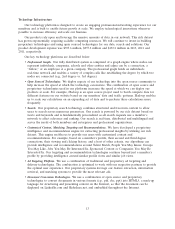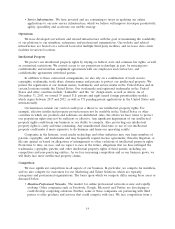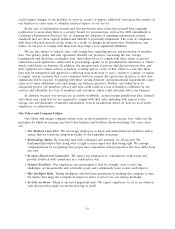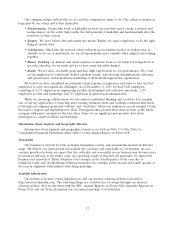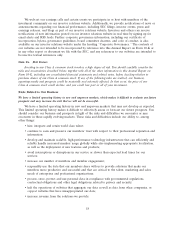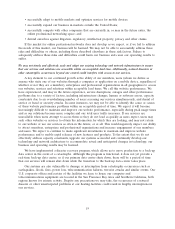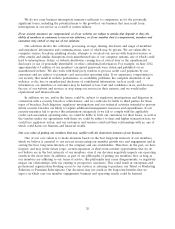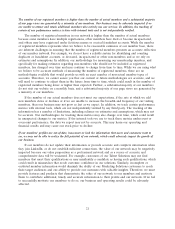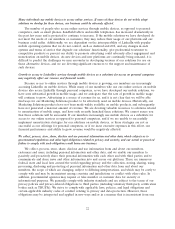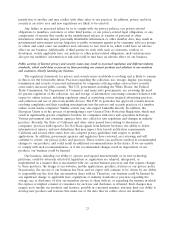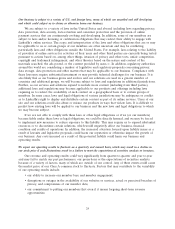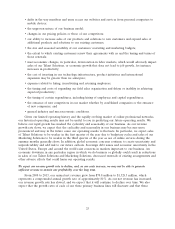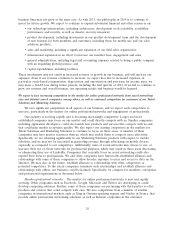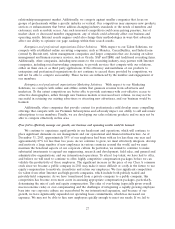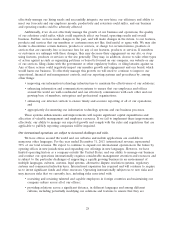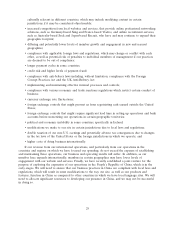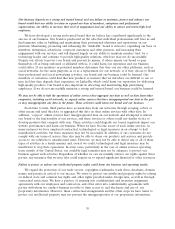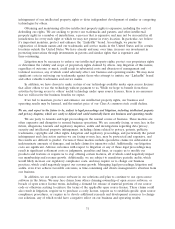LinkedIn 2013 Annual Report Download - page 23
Download and view the complete annual report
Please find page 23 of the 2013 LinkedIn annual report below. You can navigate through the pages in the report by either clicking on the pages listed below, or by using the keyword search tool below to find specific information within the annual report.The number of our registered members is higher than the number of actual members and a substantial majority
of our page views are generated by a minority of our members. Our business may be adversely impacted if we
are unable to attract and retain additional members who actively use our services. In addition, the tracking of
certain of our performance metrics is done with internal tools and is not independently verified.
The number of registered members in our network is higher than the number of actual members
because some members have multiple registrations, other members have died or become incapacitated,
and others may have registered under fictitious names or created fraudulent accounts. While the number
of registered members represents what we believe to be reasonable estimates of our member base, there
are inherent challenges in ensuring that the number of registered members presents an accurate reflection
of our member network. For example, we do not have a reliable system for identifying and counting
duplicate or fraudulent accounts, or deceased, incapacitated or other non-members and so we rely on
estimates and assumptions. In addition, our methodology for measuring our membership numbers, and
specifically for making estimates regarding non-members who should not be included as registered
members, has changed over time and may continue to change from time to time. While we are using what
we believe to be accurate methods of measuring the number of registered members, there are no
methodologies available that would provide us with an exact number of non-actual member types of
accounts. Therefore, we cannot assure you that our current or future methodologies are accurate, and we
will need to continue to adjust them in the future from time to time, which could result in the number of
registered members being lower or higher than expected. Further, a substantial majority of our members
do not visit our website on a monthly basis, and a substantial majority of our page views are generated by
a minority of our members.
If the number of our actual members does not meet our expectations, if the rate at which we add
new members slows or declines or if we are unable to increase the breadth and frequency of our visiting
members, then our business may not grow as fast as we expect. In addition, we track certain performance
metrics with internal tools, which are not independently verified by any third party. The tracking of this
information has a number of limitations, including reliance on estimates and assumptions, which may not
be accurate. Our methodologies for tracking these metrics may also change over time, which could result
in unexpected changes to our metrics. If the internal tools we use to track these metrics undercount or
overcount performance, the data we report may not be accurate. This may harm our operating and
financial results and may cause our stock price to decline.
If our members’ profiles are out-of-date, inaccurate or lack the information that users and customers want to
see, we may not be able to realize the full potential of our network, which could adversely impact the growth of
our business.
If our members do not update their information or provide accurate and complete information when
they join LinkedIn, or do not establish sufficient connections, the value of our network may be negatively
impacted because our value proposition as a professional network and as a source of accurate and
comprehensive data will be weakened. For example, customers of our Talent Solutions may not find
members that meet their qualifications or may misidentify a candidate as having such qualifications, which
could result in mismatches that erode customer confidence in our solutions. Similarly, incomplete or
outdated member information would diminish the ability of our Marketing Solutions customers to reach
their target audiences and our ability to provide our customers with valuable insights. Therefore, we must
provide features and products that demonstrate the value of our network to our members and motivate
them to contribute additional, timely and accurate information to their profile and our network. If we fail
to successfully motivate our members to do so, our business and operating results could be adversely
affected.
21




